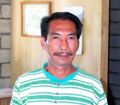The barangay is a political entity unique to the Philippines. The name is derived from the large outrigger canoes (balangay) that the early ancestors of modern Filipinos used when travelling from island to island. Originally from China, they settled first in Formosa (Taiwan) and then occupied most of the islands that are now the Philippines, Indonesia, and Malaysia.
Each outrigger canoe was led by a captain, who remained the leader of the occupants of the canoe when they settled ashore. Today, the Barangay Captain is elected and serves a term of 3 years. The Captain has a significant amount of authority. Most local disputes go before the Barangay Captain for settlement, rather than to the courts. Building permits, chopping down a tree, etc. all require the Captain's approval. Our Captain, seen in the small photo at left, is currently serving a 5-year term. (There wasn't enough money available to pay for the scheduled election so his term, and the terms of the other Barangay Committee members, were extended 2 years.)




